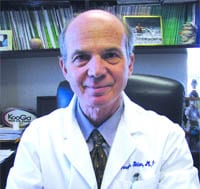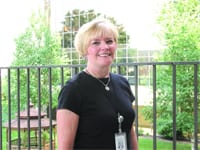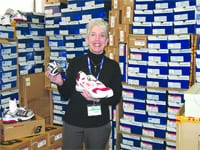What Lies Beneath Vascular Surgery Isn’t Just Skin-deep for Dr. Robert Goodman
Dr. Joseph Sklar was more than 2,000 miles away from the operating room in the Salt Lake City Hospital in which the surgical procedure to repair Tiger Woods’ knee was performed. But the Springfield-based orthopedic specialist played an important role in the work to bring a pain-free existence to the reigning U.S. Open champion.
Sklar, working in conjunction with the surgeon who led that operation, Dr. Thomas Rosenberg, developed a device called the EndoButton, a “tissue anchor,” as it’s called, that holds a piece of tissue in the bone until the tissue and bone heal together.
Withstanding the long, patience-testing process of bringing the EndoButton to the marketplace and the operating room is part of the mix of challenges and rewards that makes Sklar proud to take the unofficial title ‘inventor,’ which he has certainly earned — and relishes.
He told The Healthcare News that he has accumulated 26 patents over the years for several devices, most of them in the category of tissue anchor. The EndoButton and the IntraFix are his greatest success stories — both are widely used today — but there have been a number of other developments, and more are in the pipeline.
Sklar doesn’t have an engineering background (although his father was in that profession), but he has an inventive streak coupled with entrepreneurial tendencies that have made his device-developing activities a combination hobby and small business — endeavors that bring some different kinds of rewards.
“It’s very rewarding to work on developing these devices,” he said, adding quickly that there is far less glamour and much more old-fashioned hard work involved than most would realize. “It involves creativity and persistence, with getting a device sold to a company and then developing it.”
Sklar’s day job is as a specialist with New England Orthopedic Surgeons Inc., an affiliate of Baystate Health, where he performs a host of knee procedures including arthroscopy, rebuilding of ligaments, and procedures to combat arthritis. In the course of doing such work, he has pondered ways to make the surgeon’s job easier and (maybe) the patient’s recovery quicker.
“I was attracted to orthopedics, and shortly after I got involved I started thinking about devices that might improve the way we do surgery,” he said, explaining how he took the rather unusual step to blend inventing with a career in surgery. “I’ve learned by trial and error about how to take these ideas and bring them to reality.”
Indeed, the path from Sklar’s imaginative mind to the drawing board and then all the way to the operating table is a long, complex, often-frustrating process complete with a mix of highs and lows, he said.
Relating the story of the IntraFix, Sklar said he originally worked with Johnson & Johnson to bring it to the marketplace, but that corporation eventually passed on it.
A much smaller company picked up the ball, took the concept to the operating room, and Johnson & Johnson wound up buying that company largely because it had the Intrafix.
Capital Ideas
A look at the list of patents Sklar has collected reveals the depth of his inventing prowess — as well as the intricacy of the work being done in the operating room.
There’s No. 387,161, issued in December 1997: “surgical suture knot pusher with hooks”; No. 360,687, “combined proximal end and shaft of surgical suture slotted knot pusher”; No. 5,949,951, “interactive workstation for creating customized ‘watch-and-do physical exercise programs’”; No. 5,899,938, “graft ligament anchor and method for attaching a graft ligament to the bone”; and many others.
His first, No. 5,306,301, “graft attachment device and method of using same,” came in April 1994, and there’s usually been one — and sometimes two or even three — every year since.
Most of these devices have never seen the light of day, or the lights of the operating room, as the case may be, but this is part of life as an inventor, he said, noting that, for every product that sees mass development and even a celebrity knee surgery, untold others never get off the drawing board.
Explaining the process, Sklar said it is intriguing and often frustrating. Patience isn’t a virtue, but a necessity, he explained, adding that, in his case, he has no significant resources with which to develop prototypes or engineer devices. So he must find what he called “corporate sponsors” to move an idea forward, which can take years.
“You go to the company with an idea — and sometimes you have a patent already,” he began, describing what amounts to the best-case scenario. “And then you sell them on the idea, and then they proceed to develop it with you.”
But it’s nowhere near as simple as that sounds.
“It’s an interesting process,” he continued. “It’s not often that you’re able to get these devices accepted immediately by one company; you have to go around and shop the idea, sometimes to three or four companies, before you get one that says, ‘oh yeah, that has some potential.’”
In the case of the IntraFix, he said a division of Johnson & Johnson took a year to look over the device and render a decision, which was ultimately a ‘thanks, but no thanks.’ Sklar then took the instrument to a small company in Utah, which saw more potential and ultimately developed it. Two years later, J&J acquired the firm to get the device back.
“There are a lot of ups and downs that come with trying to get something made,” he explained. “There have been ideas that I’ve had that I’ve patented on my own that have never made any commercial success.”
But as in golf itself, it is the successes that inspire people to come back and try again.
And so, Sklar continues to bring new concepts to those corporate sponsors.
He is currently working with a company in Germany called Storz to bring a different kind of knee anchor to the market — a nearly four-year work in progress that has seen the instrument gain limited use in that country. Meanwhile, he’s working on another device, a shoulder anchor, in conjunction with an U.S. company.
News Anchor
When asked if his device-creating exploits are lucrative, Sklar joked, “I wouldn’t still be doing surgery every day if they were.”
Turning more serious, while downplaying the financial aspects of his inventing, he said the real rewards come from seeing his work make a real difference in the operating room — for patients and physicians alike.
None of the scattered news reports on Tiger Woods’ successful anterior cruciate ligament (ACL) surgery made any mention of the EndoButton, nor should they have, said Sklar, who noted that the devices he’s worked on make small but important contributions that are invisible to most people.
That’s part and parcel to this combination hobby and business, and just one of the intriguing aspects of being an inventor of medical devices.




Comments are closed.